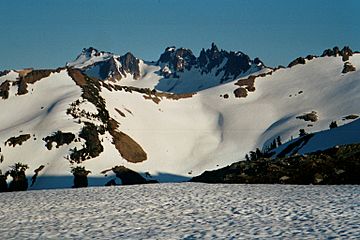Big Horn (Washington) facts for kids
Quick facts for kids Big Horn |
|
|---|---|

Big Horn is the highest spire on the right
|
|
| Highest point | |
| Elevation | 8,000+ feet (2,440+ m) |
| Prominence | 240 ft (70 m) |
| Geography | |
| Location | Lewis / Yakima counties, Washington, U.S. |
| Parent range | Cascade Range |
| Topo map | USGS Walupt Lake |
| Climbing | |
| Easiest route | Steep scramble over very loose rock, class 3s4 |
Big Horn is an impressive mountain peak found in the beautiful Cascade Range in the state of Washington, USA. Even though it doesn't have an official name, it's a very important spot. It's actually the highest point in Lewis County! Big Horn is also known for being a challenging climb, especially for adventurers who enjoy reaching the highest points in different counties.
Contents
Discover Big Horn Mountain
Big Horn is a tall mountain that stands about 8,000 feet (2,440 m) high. It's part of a group of peaks called the Goat Rocks. This area is known for its rugged beauty and amazing views. Big Horn is the second highest point on a ridge located west of Gilbert Peak. Right next to it, on the same ridge, is an even higher point called Goat Citadel.
Where is Big Horn Located?
Big Horn is nestled in the Goat Rocks Wilderness, a wild and protected area in Washington. It sits right on the border between Lewis County and Yakima County. This means that part of the mountain is in one county, and part is in another! The wilderness area is part of the Gifford Pinchot National Forest, which is a huge forest managed by the United States government.
What Makes Big Horn Special?
One of the coolest things about Big Horn is its status as the highest point in Lewis County. For many climbers, reaching the highest point in a county is a fun challenge. Big Horn is said to have one of the most difficult sections, or "pitches," on the easiest climbing routes for all 39 county high points in Washington. This makes it a special goal for experienced hikers and climbers.
Climbing Big Horn Mountain
Climbing Big Horn is not an easy task. The simplest way to get to the top involves a "steep scramble" over very loose rocks. A scramble means you often need to use your hands as well as your feet to move up the mountain. The rocks can be unstable, making the climb tricky.
The Challenging Summit
Near the very top of Big Horn, there's a specific challenge: a 10-foot (3.0 m) vertical crack. A "crack" in climbing is a narrow opening in the rock that climbers can use for handholds or footholds. The famous American climber and author, Fred Beckey, described this section as a difficult "Class 4" climb. In the Yosemite Decimal System (YDS), which is a way to rate how hard a climb is, Class 4 means you often need to use your hands and feet, and a fall could be dangerous. It's more than just hiking, but usually doesn't require ropes like harder climbs do. This tough section adds to the adventure of reaching Big Horn's summit.

